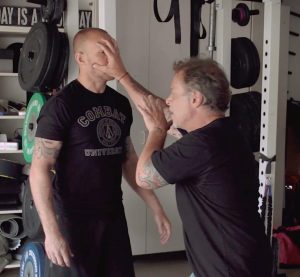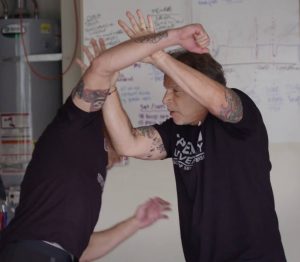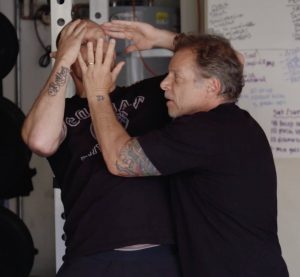The Science of Self Defense with Tony Blauer
Feb 21st 2021
Tony Blauer is a self defense pioneer whose name and expertise are well known in martial arts and MMA circles. He has regularly appeared on the covers of martial arts magazines and is a go-to expert for understanding, in practical terms, the neurological responses the body goes through when threatened. He developed the S.P.E.A.R. system, which essentially trains people how to “weaponize” the flinch response we all have when faced with an attack.
Our friend Clint Emerson, New York Times best-selling author of 100 Deadly Skills and Escape the Wolf, met with Tony to learn how to weaponize the fear response using the S.P.E.A.R. system.
When properly and regularly trained, the S.P.E.A.R. system can turn your body’s natural fear response into a tool for de-escalation, and, when appropriate, a weapon for neutralizing an adversary.
What Does S.P.E.A.R. Stand For?
S.P.E.A.R. is an acronym that stands for a seamless adaptation of the human fear response, otherwise known as the flinch. In other words, theS.P.E.A.R. system (Spontaneous Protection Enabling Accelerated Response) turns the somewhat embarrassing reflex into its intended purpose: a built-in tool for survival.

“What I’ve mastered is the ability to look at fear and recognize the psychology of fear,” Tony says. “And I love the acronym F.E.A.R.– False Expectations Appearing Real. The natural tendency is to let those future events immobilize us in the present.”
Instead, Tony has spent decades–since the age of 19–perfecting and training F.E.A.R. into S.P.E.A.R. by harnessing the psychology and neuro-physiology into a simple reflex that creates readiness and effectiveness in the face of attack.
It really focuses on how we respond to a threat; the body mechanics, the neurology behind it, and putting it all together so you can have an edge against your adversary from the very beginning.
Change Your Relationship with Fear using the S.P.E.A.R.
Tony got the name S.P.E.A.R. from the shape the hands take when they instinctively go up in the face of an attack. This hand position, he says, is the perfect start to a defensive stance. Clint sums up Tony’s observations:
“Essentially, the body reacts in less than a second to anything that startles us. It all starts with the brain. Your brain sends a message down the body. From the point of when you’re scared, you immediately blink and then your head moves, your neck moves, your shoulders crunch up, your hands start to come up to protect your brain, which is sending the message in the first place. Then it makes its way down the rest of your body, where your core tightens up, your adrenaline flows, and then your feet get into position.”
Non-Violent Posture
Tony first encourages what many other self-defense experts encourage–don’t broadcast your fear or your next move.
“When we talk about feigning compliance or pretending to be compliant to your adversary, it’s all anchored to the non-violent posture,” says Clint. “Tony is the guy who developed this concept, and you’ll see that all these experts use it.”
The non-violent posture is partly designed to avoid a fight, but it’s also about gaining a tactical advantage. You don’t want to escalate the situation prematurely, and you don’t want to ruin the element of surprise. This requires that all-important non-violent posture.

The non-violent posture is whatever you make it,” Tony says, recommending a natural stance from which you can also deliver strikes. “You just have to make sure you train it.”
If a would-be assailant seems to be getting aggressive with you, but isn’t close enough to hit you, he might still be willing to back off. Don’t give him any more reason to go after you than needed, but be ready to take him out if the time comes.
“Body language should be congruent with where things are in the confrontation,” Tony says. “And you should learn to fight from the non-violent posture.”
Whether your non-violent posture is arms crossed, hands on hips, fingers in your pockets or that contemplative hand-on-chin pose–you need to train from it.
Train Your Response
From the non-violent posture, train your body to respond with defensive tactics and aggressive action. This means training to be ready in fractions of a second, which means weaponizing your flinch reflex from your non-violent posture.
This is where the S.P.E.A.R. system comes into the equation. This Spontaneous Protection Enabling Accelerated Response is basically just a fancy way of saying use your flinch reflex in your favor. This 100,000-year-old survival mechanism, with training, can immediately position your body with hands up, elbows locked at 90 degrees, feet anchored to the ground, and back straight and angled slightly toward the threat.
Move Into Your Adversary. From this position, you can move into your adversary’s attack and too close for his fists to strike. From there you can do what’s necessary. And, remember,. Sometimes moving away from danger can put you in more danger. Often moving into an opponent puts you at the advantage.
Use a palm index strike and Face Grab. Follow up with a palm strike to the ridgeline of his jaw and send his face looking skyward, or apunch to the chest, or even a palm strike to the jaw. Tony fixates on this jaw line because it’s easily accessible from multiple angles no matter where the assailant turns their head. Plus, it exploits their weak spot–the back of their neck.

Lead Hand. Rear Hand. Your tactical stance should contain a lead foot and rear foot. In the same way, it should also involve a lead hand and rear hand–not too foreign a concept in boxing. With the lead hand, grab their face. With the rear hand, jack their jaw.
Recycle Kinetic Energy. Tony describes the idea of recycling kinetic energy as a way of using the adversary’s force against you by throwing it right back at him. If your stance is properly trained, then you’ll naturally “recoil” and can use that energy.
Fire with the Closest Weapon at the Closest Target. As described above, strike the adversary in the best and closest target on their body given the circumstances. Of course, again, Tony emphases the face and jaw, but the important point is to strike them at their vulnerability with as much force as you can. This is about survival.
Don’t Focus on Technical Training. Focus on Tactical Application. Train as much as possible in real-world simulations and scenarios. Technical training is important for having proper stances, postures, etc., but this is only as good as its tactical application. So the key is to engage with training partners who can help create stressful situations and develop situational muscle memory.
It’s All Split Seconds. Fights and attacks don’t take long. They’re usually over in seconds, so you only have split seconds to respond and react. By training and repetition you can increase your odds of survival and dominance against people who want to do harm –to you and your loved ones.
To watch Clint Emerson’s full interview with Tony Blauer and other defense experts, subscribe to the Warrior Poet Network.
Be on the lookout for more warrior profiles on our blog.

